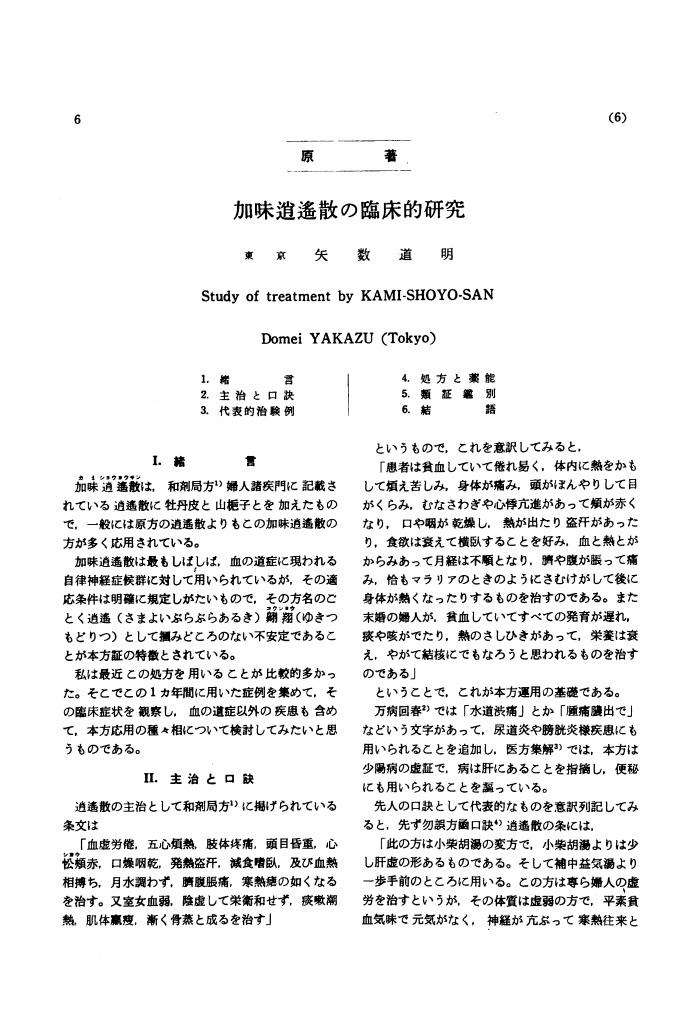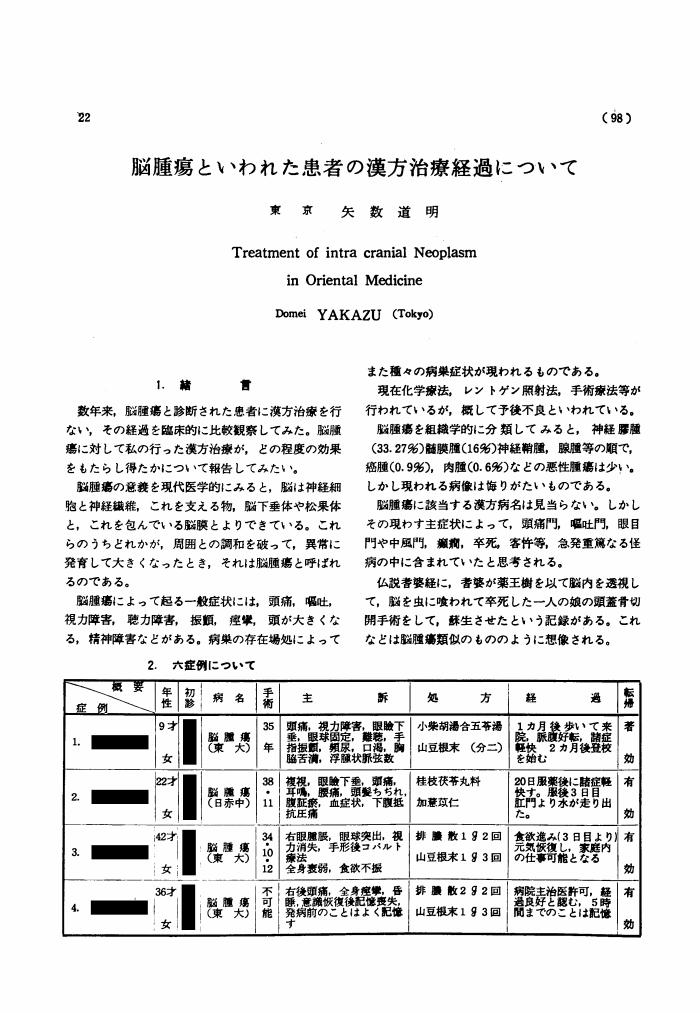4 0 0 0 OA 於血をめぐって
- 著者
- 矢数 道明
- 出版者
- The Japan Society for Oriental Medicine
- 雑誌
- 日本東洋醫學會誌 (ISSN:1884202X)
- 巻号頁・発行日
- vol.25, no.4, pp.165-185, 1975-06-30 (Released:2010-10-21)
- 参考文献数
- 21
In Oriental medicine diseases have been explained as the products of Oketsu, Suidoku or Shokudoku. Oketsu means the stagnation of disordered blood, which should appear in various febrile diseases, women in childbed, contusions and individuals of hereditarily idiosyncratic constitution. Suidoku means intoxication caused by disturbances of water metabolism, while Shokudoku means intestinal autointoxication caused by unbalanced diet. Each of these three factors causes in its turn various specific diseases respectively.In “Shang han lun” and “Chin kuei yao lüeh” (217 A. D.) of Chang Chung-ching are given many formulas for combatting Oketsu, Suidoku and Shokudoku, and they have been used successfully.There are some different principles of healing Oketsu, namely; to bring disordered blood circulation into normal condition, to restore disordered blood and remove the stagnation, and to dissolve blood clots to normalize blood circulation.In the last case of the above three various drugs of animal origine are used in combination with those of vegetable origin. They are, for instance, leeches, gadflies, opisthoplatia orientalis, larvae of coprides species and others. It is interesting that worn-out dish rags and dirty straw mats were used as remedies for contusions. The animals providing such drugs live mainly in dirty mud or decomposed matter, that is; they are resistant to dirty or decomposed environment. The others such as leeches or gadflies contain anticoagulant substances.Throughout the history of Oriental medicine so called “sympathetic drugs” have been used, which share the thought of “Similia similibus curantur” with Homöopathy.A series of studies by Dr. Knisely and others in the last 40 years or so on “Sludged blood”, coagulation of red blood cells in blood vessels, seems to provide some available explanations of Oketsu. A new way of healing diseases with blood coagulation could be found out through clinical studies of Oketsu on the basis of the traditional context of Oriental medicine.
3 0 0 0 OA 曲直瀬道三の医学について
- 著者
- 矢数 道明
- 出版者
- The Japan Society for Oriental Medicine
- 雑誌
- 日本東洋医学雑誌 (ISSN:02874857)
- 巻号頁・発行日
- vol.42, no.2, pp.189-203, 1991-10-20 (Released:2010-03-12)
- 著者
- 矢数 道明 真柳 誠 室賀 昭三 小曽戸 洋 丁 宗鉄 大塚 恭男
- 出版者
- The Japan Society for Oriental Medicine
- 雑誌
- 日本東洋医学雑誌 (ISSN:02874857)
- 巻号頁・発行日
- vol.38, no.2, pp.103-112, 1987
- 被引用文献数
- 3
筆者らは日本の医科・歯科・薬科大学 (学部) における, 伝統医学教育についての調査を実施した。本報では当調査結果のうち, 以下の項目に関する統計分析を報告した。<br>1) 伝統医学教育における問題点<br>2) 教育の展望<br>3) 今後導入がなされるべき課程<br>この結果, 伝統医学教育を未実施校の過半数がその理由に教育時間不足と担当者の不在を挙げること。現在実施中と今後実施の可能性のある校を合わせると, 全体平均では37%に達っすること。医科・歯科大学では, 今後は臨床医学系教科と自由講座中にて教育が導入される傾向の高いこと。薬科大学では, 現況の独立教科以外に自由講座・卒後教育などにも導入が進む傾向のあることが知られた。
1 0 0 0 OA 後世派医学の立場から
- 著者
- 矢数 道明 渡邊 武
- 出版者
- 一般社団法人 日本東洋医学会
- 雑誌
- 日本東洋醫學會誌 (ISSN:1884202X)
- 巻号頁・発行日
- vol.18, no.2, pp.50-56, 1967-09-30 (Released:2010-10-21)
- 参考文献数
- 20
1 0 0 0 OA 加味逍遙散の臨床的研究
- 著者
- 矢数 道明
- 出版者
- The Japan Society for Oriental Medicine
- 雑誌
- 日本東洋醫學會誌 (ISSN:1884202X)
- 巻号頁・発行日
- vol.14, no.1, pp.6-17, 1963-07-31 (Released:2010-10-21)
- 参考文献数
- 11
1 0 0 0 OA 防巳黄耆湯の運用について
- 著者
- 矢数 道明
- 出版者
- The Japan Society for Oriental Medicine
- 雑誌
- 日本東洋醫學會誌 (ISSN:1884202X)
- 巻号頁・発行日
- vol.11, no.4, pp.148-151, 1961-03-31 (Released:2010-10-21)
1 0 0 0 OA 胎児性別の脈診腹診に依る判定法
- 著者
- 矢数 道明
- 出版者
- 一般社団法人 日本東洋医学会
- 雑誌
- 日本東洋醫學會誌 (ISSN:1884202X)
- 巻号頁・発行日
- vol.1, no.1-6, pp.11-13, 1950 (Released:2010-10-21)
1 0 0 0 OA 尾張藩医宗浅井家の業績と国幹の「告墓文」について
- 著者
- 矢数 道明
- 出版者
- The Japan Society for Oriental Medicine
- 雑誌
- 日本東洋医学雑誌 (ISSN:02874857)
- 巻号頁・発行日
- vol.44, no.3, pp.263-273, 1994-01-20 (Released:2010-03-12)
1 0 0 0 OA 脳腫瘍といわれた患者の漢方治療経過について
- 著者
- 矢数 道明
- 出版者
- The Japan Society for Oriental Medicine
- 雑誌
- 日本東洋醫學會誌 (ISSN:1884202X)
- 巻号頁・発行日
- vol.15, no.3, pp.98-99, 1965-03-20 (Released:2010-10-21)






